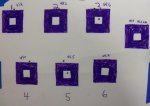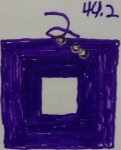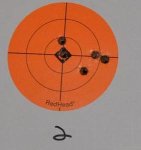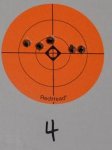M96 Swede, 6.5x55, 22" bbl, SWFA SS10x42, glass beded Butler Creek (steel rod/fiberglass reinforced and free floated forend), Dayton Traister trigger- consistent 1.0-1.1#, prone on a harris.
140gr Hornady SST
IMR4350
CCI200
3.150" OAL
The target is sharpie on lined posterboard. White squares are 1", Purple squares are 3", the purple squares MILed just barely under 1MIL, at what was supposed to be 100yds.
Spot= 41.4, 42.2, 43.0.
Then a "round robin" with 1 round from each group, with a 70-one-thousand count before chambering the next round. I ran the spotters, 1,2,3 before the line was called cold. Then 4,5,6,1,2,3,4,5,6,1,2,3 before it was called again. And finally 4,5,6. Then I cranked the elevation down 3 clicks (.3mil), and ran the 4 rounds @42gr in the lower group of the spotter target with ~5 seconds between each round.
1= 43.8gr 2= 44.2gr 3= 44.6gr
4= 45.0gr 5= 45.5gr 6= 45.9gr

Are there multiple nodes (2,4,6 & 42gr spotters) or is my form just that rusty?
Should I bracket from 44-45gr and run the test again?
Thanks,
John
140gr Hornady SST
IMR4350
CCI200
3.150" OAL
The target is sharpie on lined posterboard. White squares are 1", Purple squares are 3", the purple squares MILed just barely under 1MIL, at what was supposed to be 100yds.
Spot= 41.4, 42.2, 43.0.
Then a "round robin" with 1 round from each group, with a 70-one-thousand count before chambering the next round. I ran the spotters, 1,2,3 before the line was called cold. Then 4,5,6,1,2,3,4,5,6,1,2,3 before it was called again. And finally 4,5,6. Then I cranked the elevation down 3 clicks (.3mil), and ran the 4 rounds @42gr in the lower group of the spotter target with ~5 seconds between each round.
1= 43.8gr 2= 44.2gr 3= 44.6gr
4= 45.0gr 5= 45.5gr 6= 45.9gr

Are there multiple nodes (2,4,6 & 42gr spotters) or is my form just that rusty?
Should I bracket from 44-45gr and run the test again?
Thanks,
John
Last edited:








